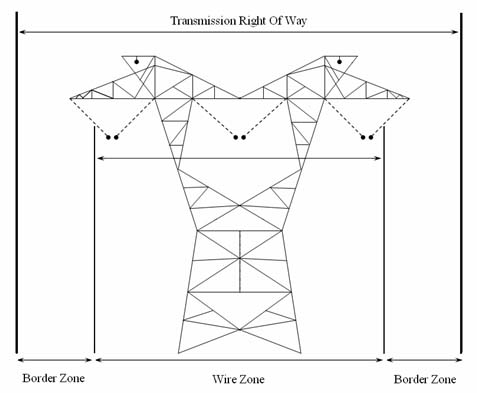Transmission Vegetation Management
Carrying Power Long Distances
Transmission lines are the long-haul carriers of the electricity flowing through our state. Find out how we work to reduce hazards that could impact these important components of our electrical system.
Unlike the power lines you see next to your local roads, transmission lines are typically constructed on large metal towers located within the Rights-of-Way on PSE&G easements and company-owned land that have been cleared of incompatible vegetation. The lack of trees is no accident. A tree in close proximity to a transmission line has the potential to short-out the line, which will cause a hazardous electrical current to traverse through the ground. This would be a serious situation that could inflict significant property damage and create a variety of safety concerns and put the safety of the general public and the lives of our employees at risk. That's why PSE&G proactively maintains the vegetation near transmission lines.
The New Jersey Board of Public Utilities (BPU) has made vegetation maintenance a major priority since the blackout of August 14, 2003. Vegetation management regulations require that an integrated vegetation management (IVM) approach be utilized on the border zone. This would allow for, in most cases, low-growing compatible species to remain in this area. The regulations also require that woody vegetation that naturally matures to a height of 3 feet or greater be removed from the wire zone of the transmission Rights-of-Way.
Where the Transmission Lines are Located
The metal towers to which the transmission lines are connected are located on PSE&G right-of-way easement land and on land owned by the company.
Tree maintenance regulations require specific attention to vegetation management in these areas.
Species that grow low may remain in the area, but large trees and plants that naturally grow to a height of three feet or more must be removed from cable laying areas.
Important Safety Guidelines to Remember
- Contact PSE&G’s vegetation management department before planting any vegetation within the Rights-of-Way to confirm compatibility.
- No buildings, swimming pools, decks, sheds, barns, garages, fences, or any other structures can be located within the Rights-of-Way.
- No lighting fixtures are permitted to be placed under the Rights-of-Way.
- Septic systems and wells cannot be located within the Rights-of-Way.
- No materials of any kind are allowed to be hung or affixed to the Transmission Rights-of-Way Towers or any other Rights-of-Way structures.
- All roads or paths permitting access to transmission Rights-of-Way structures must be clear and unobstructed.
- Excavations near Transmission Structures are not permitted without proper approval from PSE&G.
- Activities such as kite flying and model airplane flying are prohibited on or near the Rights-of-Way.
Tree Trimming Near Your Home
Want to see if we have planned maintenance work in your town? Check the schedule to see where we will be performing vegetation maintenance this year. Please note that most vegetation management is planned, proactive work that ensures the reliability of our system. It is possible you may see work that hasn't been announced. This is due to an imminent issue and it is not considered planned maintenance.
The Rights-of-Way do not have to be void of all vegetation. Check here for examples of trees that may possibly be compatible within the Rights-of-Way. Please be aware, the compatibility of vegetation within a Rights-of-Way is dependent on site specific conditions and only authorized PSE&G vegetation management personnel can make that determination. Please contact us before planting anywhere within a Rights-of-Way.























